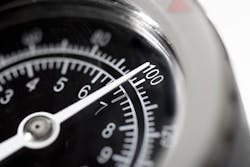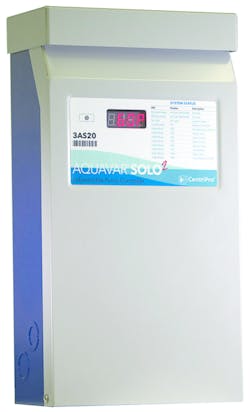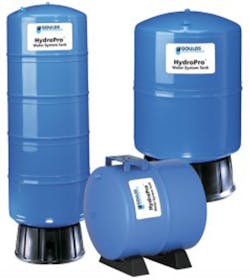Americans are becoming smarter water consumers, according to a 2016 study by the Water Research Foundation (WRF). The study revealed a 22 percent drop in average annual indoor household water use since WRF’s 1999 study. In addition to the use of water-efficient appliances and fixtures that are responsible for most of the reduction, homeowners can reduce water use by regulating water pressure.
When the pressure is too high, water is often wasted. When it is too low, it can take twice as long to complete a task, which also wastes water.
Homes with private wells, common in rural areas, can experience inadequate or low water pressure because of decreasing well levels, increased water use or a newly installed lawn irrigation system. Shallow wells or those dug near older homes are often inadequate for modern applications because their foundations can become unstable. With a well, the system, ideally, will automatically shut off the pump if it detects no water, loses prime, or is in over-current or voltage situations to help avoid costly repair.
For cases like these, homeowners need water pressure that will not let up. Residential water providers deliver solutions that monitor household water demand and calibrate to match system requirements, maintain water pressure and system efficiency, and reduce costs.
Regulate flow
Image courtesy of Goulds Water Technology
Water fluctuations often occur when homeowners conduct multiple water-related activities at once, such as showering and watering the garden, or doing laundry and running the dishwasher.
Installing a constant pressure system can alleviate water pressure inconsistency, providing homeowners with continuous, high-pressure water for all household needs at any time. The system operates with a variable frequency drive (VFD) pump controller that automatically monitors household water demand. Like the cruise control on a car, the VFD speeds up or slows down the pump depending on household water requirements.
The system draws water from a well to control pressure. Most residential well systems are designed to run at a pressure of 40 to 60 psi. As the water in the well is depleted, the pressure starts to fall, and homeowners can experience water pressure fluctuations. A constant water pressure system boosts water pressure to the desired level and maintains that pressure even while multiple water sources are in use.
A constant pressure system features several other benefits for installers and homeowners, including:
- A soft start/stop feature that reduces or eliminates noisy pipes
- Total system protection, to avoid costly repairs by automatically shutting off the pump
- Ability to have a more compact layout using the existing pressure tank or a smaller tank
- Easy system expansion
- Energy and operational cost savings
When a VFD is installed properly, it allows appliances to work more efficiently, extending their life, reducing energy consumption, and decreasing mechanical and electrical system stress.
Maintain pressure
Image courtesy of Goulds Water Technology
When a homeowner opens a spigot, he or she expects water to flow at a certain speed. Water pressure in the line causes that water to flow. If the home is on a well, it needs something to build that pressure, which is when a pressure tank comes into play.
Here is how pressure tanks work: The pressure tank in a water well system creates water pressure by using compressed air to bear down on the water. Because of this pressure, when a valve is opened, water is pushed out of the tank through the pipes in the home. When the water in the pressure tank drops below the required amount, a pressure switch is activated, turning on the pump. The pump then refills the pressure tank. The combination of the pressure tank, pressure switch and pump enables water to flow through a home.
Pressure tanks also serve as reservoirs for the home and are generally set to keep pressure within 20 psi of an average single-family home’s water capabilities starting and stopping parameters. For example, most homes have water pressure of 40 to 60 psi. If the pressure drops below 40 psi, the pump kicks on and brings the pressure back to 60 psi before cutting off again.
Because the tank acts as a reservoir, water can be drawn from the tank without the pump cycling on and off each time the water is turned on. This ultimately protects and prolongs the life span of the pump. Water pressure tanks also reduce instances of water hammer by decreasing the amount of air in the pipes and controlling the water pressure.
When choosing a pressure tank, professional installers will need to know the gallons per minute the pump pushes water through the pipes. If gallons per hour are required, multiply that number by 60. Additionally, they will count the number of plumbing fixtures, including the outside spigots the system needs to service.
Most manufacturers provide a chart to help size a pressure tank. Often, professional installers will lean toward selecting larger pressure tanks to extend the life of the product and avoid replacement.
Rely on the pros
Because of the multitude of complex electronics in constant pressure systems and water pressure tanks, this is not a do-it-yourself job. It is best to hire a professional installer.
Professional contractors and plumbers should be licensed, certified and educated on installation and the latest water system technologies. Many belong to professional associations that focus on providing continuing education to stay current on the most efficient technologies, products and industry trends.
People often consult friends and neighbors when searching for a trusted certified installer. Additionally, local industry professionals such as roofers, electricians or HVAC repair technicians can be valuable resources for referrals. Constant pressure system manufacturers also may be able to point to a reputable certified installer. Some manufacturers provide a searchable database of independent installers by location.
By coordinating with a professional to install new systems or to retrofit older ones with constant pressure systems or water pressure tanks, homeowners can ensure they receive and conserve precious water resources wisely within their households.
Chris Preston is a global residential water product manager with expertise in submersible and jet pumps and in residential pumping systems. For more than 10 years, he has worked for Xylem Inc. and its Goulds Water Technology brand as a product design engineer and project manager on multiple global new product development projects. Preston holds a bachelor of science degree in mechanical engineering from Clarkson University. For more information on Goulds Water Technology, visit goulds.com.




